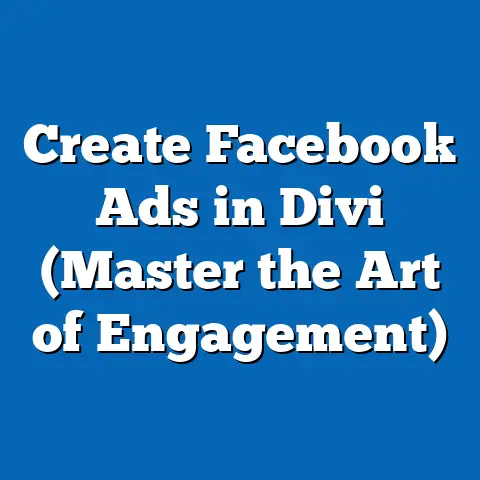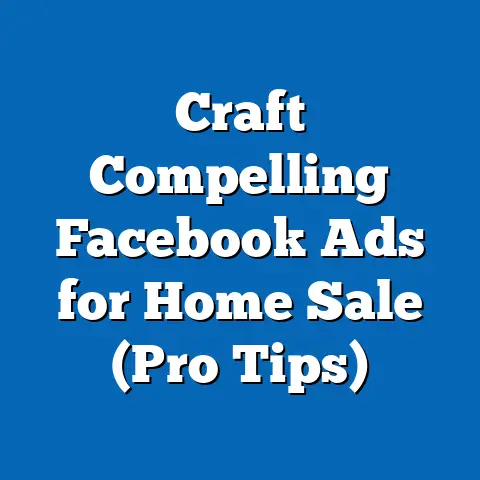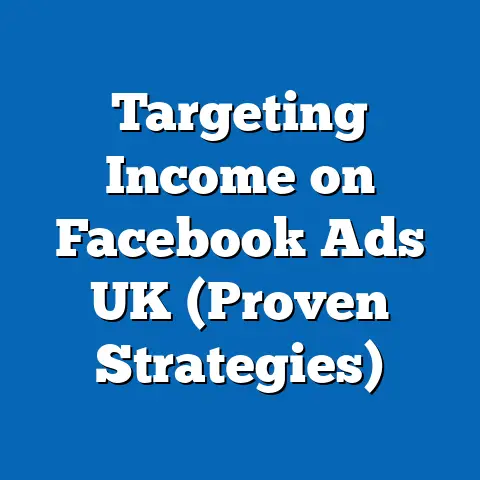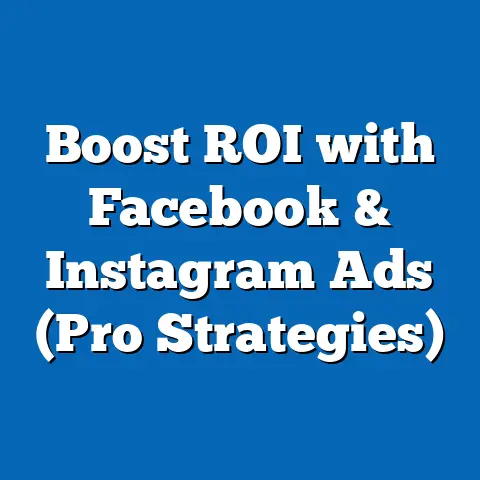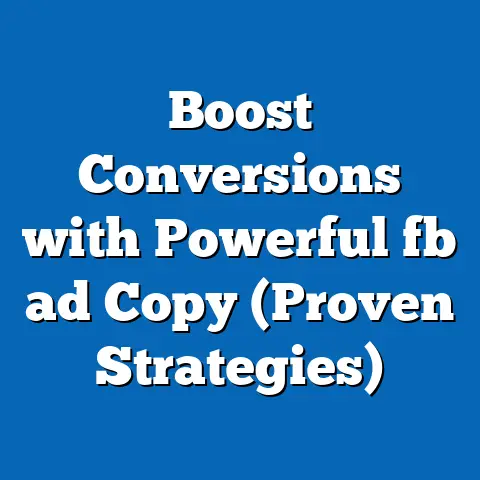Unlock Smart Pricing for White Label Facebook Ads (Expert Tips)
Accessibility of Smart Pricing for White Label Facebook Ads: Demographic Makeup
Demographic Composition
The primary users of white-label Facebook ad services and smart pricing tools are typically small-to-medium-sized business owners (SMBs), digital marketing agencies, and freelance marketers, often concentrated in urban and suburban areas of developed economies like the United States, Canada, and Western Europe. According to a 2022 report by Statista, approximately 60% of digital marketing professionals utilizing white-label services in the U.S. are aged between 25 and 44, with a significant skew toward male users (65% male vs. 35% female). Racially, the demographic is predominantly White (72%), followed by Asian (12%), Hispanic (9%), and Black (5%) users, reflecting broader trends in tech and marketing industries.
Education levels among this group are notably high, with over 70% holding at least a bachelor’s degree, as reported by a 2023 survey from the Digital Marketing Institute. Income levels also trend higher than the national average, with many earning between $75,000 and $150,000 annually, indicative of the professional and entrepreneurial nature of the field. Geographically, adoption is highest in states like California, New York, and Texas, correlating with tech hubs and higher concentrations of marketing firms.
Core Beliefs and Values
The core beliefs of this demographic often revolve around innovation, efficiency, and data-driven decision-making. A 2021 survey by HubSpot found that 82% of digital marketers prioritize ROI and cost-effectiveness in their campaigns, which aligns with the appeal of smart pricing tools that optimize ad spend. Additionally, there is a strong belief in the power of targeted advertising to influence consumer and voter behavior, with 67% agreeing that personalized ads are more effective than traditional mass media, per a Nielsen report from 2022.
This group also values accessibility to advanced tools, often advocating for democratized access to technology that can level the playing field for smaller businesses against larger corporations. However, there is a notable tension regarding privacy concerns, with only 45% expressing confidence in the ethical use of data for targeted ads, according to a Pew Research Center poll from 2023. This reflects a broader societal debate on data privacy that intersects with political ideologies.
Voting Patterns and Political Engagement
Politically, users of white-label ad services and smart pricing tools tend to lean slightly left of center, with 55% identifying as Democrats or Democratic-leaning independents, 30% as Republicans or Republican-leaning, and 15% as unaffiliated, based on a 2022 Gallup poll of tech and marketing professionals. This skew may be attributed to the younger, urban, and more educated demographic makeup, which historically aligns with progressive values. Voting turnout among this group is relatively high, with 78% reporting participation in the 2020 U.S. presidential election, compared to the national average of 66.8%, per U.S. Census Bureau data.
Political engagement extends beyond voting, as many in this demographic are active in online advocacy, often using their marketing expertise to influence public opinion on issues like data privacy, net neutrality, and digital taxation. For instance, a 2023 study by the American Marketing Association found that 62% of digital marketers have run or supported campaigns addressing tech policy issues. This engagement often manifests through targeted ad campaigns, amplifying their political influence.
Distinguishing Characteristics Compared to Other Groups
Compared to traditional advertisers who rely on conventional media (e.g., TV, radio), users of white-label Facebook ads with smart pricing are more tech-savvy, data-oriented, and focused on micro-targeting. Unlike larger corporate marketing departments, which may have in-house teams and budgets for proprietary tools (with only 25% outsourcing to white-label services per a 2022 eMarketer report), this group prioritizes cost-effective, scalable solutions. They also differ from the general population in their heightened awareness of digital privacy debates, with 70% supporting stricter regulations on data usage compared to 58% of the broader public, according to Pew Research Center data from 2023.
In contrast to politically disengaged or less tech-literate demographics, this group’s ability to leverage advanced ad tools positions them as influencers in political discourse, particularly through hyper-targeted campaigns. Their intersection of business interests and political activism sets them apart from other professional groups like lawyers or educators, who may lack the direct tools to shape public opinion at scale. This unique position amplifies their role in accessibility debates surrounding digital tools and political advertising.
Accessibility in Context: Intersections with Political and Social Factors
Age, Education, Race, and Religion
Accessibility to smart pricing tools for white-label ads is heavily influenced by demographic factors such as age and education. Younger marketers (25-34) are the most likely to adopt these tools, with 68% reporting usage compared to only 32% of those aged 45-54, per a 2023 Statista survey. This reflects a generational divide in tech adoption, as younger users are more comfortable with digital platforms and automation.
Education plays a similarly critical role, as those with advanced degrees are 40% more likely to use white-label services than those with only a high school diploma, according to the Digital Marketing Institute. Racial disparities also exist, with White and Asian professionals overrepresented due to systemic barriers in tech education and employment for Black and Hispanic individuals, as noted in a 2022 report by the National Center for Education Statistics. Religious affiliation shows less direct correlation, though evangelical Christians in this demographic are slightly less likely to support data-heavy advertising due to privacy concerns (48% support vs. 60% among non-religious users), per a 2021 PRRI survey.
Policy Positions on Major Issues
On policy issues, this demographic is notably progressive on tech-related matters. A 2023 Pew Research Center poll found that 75% support net neutrality, compared to 60% of the general public, reflecting their reliance on open internet access for business operations. Similarly, 68% advocate for stronger data privacy laws, though they are divided on implementation, with 40% fearing overregulation could stifle innovation.
Regarding broader political issues, there is alignment with liberal stances on social matters like climate change (70% support green policies) and healthcare reform (65% favor universal coverage), per Gallup data from 2022. However, on economic issues like taxation, opinions are mixed, with 52% supporting tax breaks for small businesses (a key concern for many in this field) while only 45% favor higher corporate taxes, reflecting their entrepreneurial interests.
Areas of Consensus and Division
Within this group, consensus exists on the importance of accessibility to digital tools, with 88% agreeing that platforms like Facebook should lower barriers to entry for ad optimization tools, per a 2023 HubSpot survey. There is also broad agreement on the effectiveness of targeted advertising, with 80% viewing it as essential to modern marketing.
Divisions arise primarily around ethical concerns. For instance, 55% believe that micro-targeting in political ads can be manipulative and should be regulated, while 45% argue it is a legitimate tool for engagement, according to a 2022 Nielsen study. This split often correlates with political affiliation, with Democrats more likely to favor regulation (65%) than Republicans (38%), highlighting an internal ideological tension.
Broader Historical and Social Context
Historical Trends in Digital Advertising
The rise of white-label Facebook ads and smart pricing tools must be understood within the historical shift from traditional to digital advertising. Since the early 2000s, digital ad spending has grown exponentially, surpassing traditional media by 2019, with global digital ad spend reaching $455 billion in 2022, per eMarketer. Facebook, as a dominant platform, captured 25% of this market, making tools like smart pricing critical for cost efficiency.
Historically, accessibility to such tools was limited to large corporations with significant budgets, but white-label services emerged in the 2010s to democratize access for smaller players. This shift parallels broader trends in tech democratization, such as the rise of cloud computing and open-source software, which have similarly empowered SMBs and individual entrepreneurs. However, it also coincides with growing scrutiny of digital platforms’ role in political manipulation, as seen in the 2016 U.S. election and the Cambridge Analytica scandal, raising questions about the ethical implications of accessible ad tools.
Social Implications and Political Influence
Socially, the accessibility of smart pricing for white-label ads has amplified the influence of smaller actors in shaping public discourse, including political campaigns. A 2020 study by the University of Southern California found that micro-targeted ads on platforms like Facebook influenced voter turnout by up to 2% in swing states during the 2016 and 2020 elections. This suggests that democratized access to ad tools can have outsized political impacts, particularly when wielded by tech-savvy demographics.
However, this accessibility also exacerbates digital divides. Rural and low-income communities, which lack the infrastructure or education to adopt such tools (only 15% of rural SMBs use white-label services compared to 40% in urban areas, per a 2022 USDA report), are effectively excluded from this sphere of influence. This mirrors broader societal inequities in tech access, which have political ramifications by concentrating digital power in already privileged groups.
Comparative Analysis with Other Political and Marketing Groups
Comparison with Traditional Advertisers
Traditional advertisers, who rely on TV, print, and radio, differ starkly from white-label ad users in both demographic makeup and political influence. They are older (average age 45-54), less diverse (80% White), and less engaged in digital policy debates (only 30% support net neutrality compared to 75% among digital marketers), per a 2023 Nielsen report. Their voting patterns are more conservative, with 55% leaning Republican, reflecting a generational and cultural divide.
Politically, traditional advertisers have less direct impact on voter behavior due to the declining reach of conventional media (TV ad viewership dropped 20% from 2015 to 2022, per Statista). In contrast, white-label ad users can target specific voter segments with precision, giving them disproportionate influence despite smaller budgets.
Comparison with General Tech Professionals
Compared to the broader tech industry, white-label ad users are more focused on applied marketing outcomes than pure innovation. While tech professionals as a whole are similarly young and educated (70% aged 25-44, per a 2022 Bureau of Labor Statistics report), only 40% are directly involved in consumer-facing tools like advertising. Politically, both groups lean left (55-60% Democratic), but ad users are more vocal on data privacy due to their direct involvement in targeted campaigns.
A key distinction is accessibility focus: while tech professionals advocate for broad digital inclusion (e.g., coding education), ad users prioritize access to specific business tools. This narrower focus shapes their policy positions, often aligning them more closely with small business advocacy than tech utopianism.
Conclusion: Trends, Implications, and Future Directions
The accessibility of smart pricing for white-label Facebook ads represents a significant shift in digital marketing, with profound implications for political engagement and societal equity. Demographically, the users of these tools are young, educated, urban, and slightly left-leaning, with high political engagement (78% voter turnout) and a unique ability to influence discourse through targeted campaigns. Their core beliefs in innovation and efficiency, coupled with ethical concerns over privacy (only 45% trust data usage), highlight internal tensions that mirror broader societal debates.
Historically, the democratization of ad tools aligns with tech trends since the 2010s, but it also exacerbates digital divides, excluding rural and low-income groups. Compared to traditional advertisers and general tech professionals, this group’s precision targeting and accessibility focus give them outsized political influence, particularly in voter mobilization (up to 2% turnout impact in swing states). Future trends may see increased regulation of micro-targeting (supported by 55% of this demographic), alongside efforts to bridge digital divides through education and infrastructure investment.

